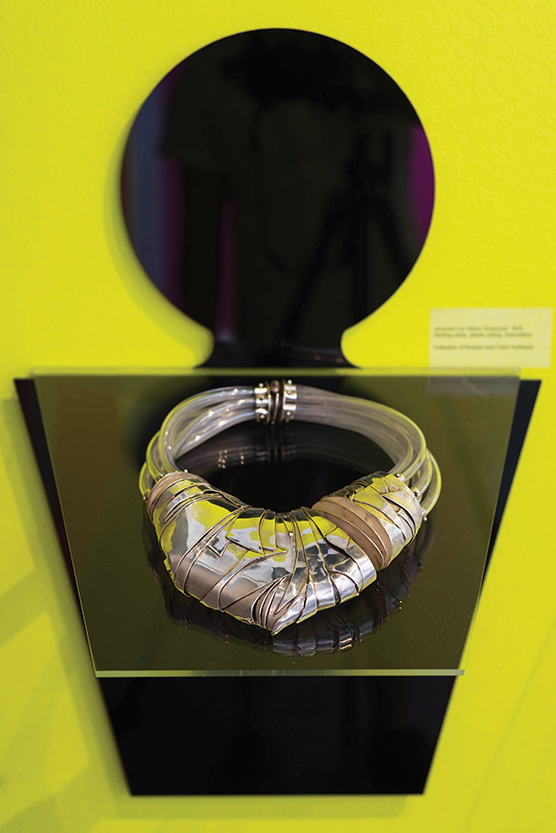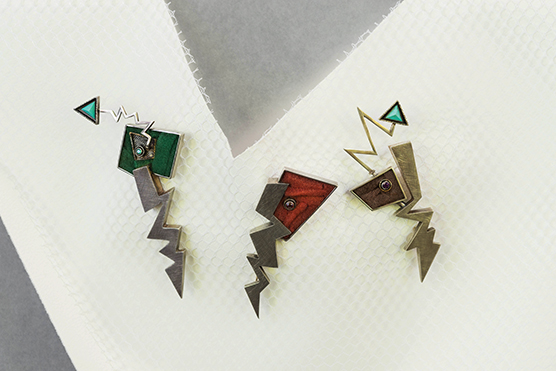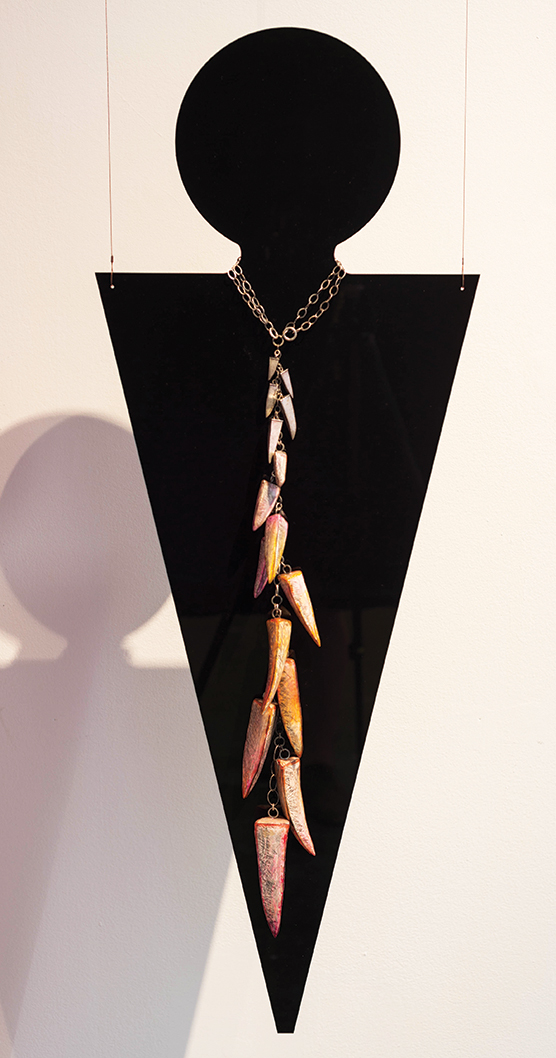
Nominated by her peers and celebrated by the Houston community, Sandie Zilker was named the 2014 Texas Master by Houston Center for Contemporary Craft (HCCC). As a result, she received the opportunity to show her work in a brilliant solo exhibition and now joins an elite roster of former Texas Masters, all of whom were recognized for their roles as career artists in Texas who have made a significant impact on the field of craft.
Zilker’s solo exhibition serves as a retrospective of her jewelry work over the past four decades. Using the body as a frame of reference, she pulls from elements of illusion and surprise to elevate adornment to its fullest potential. Each of her pieces is packed with personality, increasing the wearer’s senses and creating a unique relationship between wearer and object.
After graduate school, Zilker began experimenting with very large, hollow layered pieces. Armoured Car Elbow Ornament, 1975 (fig. 1), demonstrates the artist’s ability to manipulate metal into numerous folds and incorporate both the precious (moonstone) and the discarded (plastic tubing) into wearable form. Within a few years, her work shifted towards the more formal elements of design. The Zig Zag brooch series, 1989 (fig. 2), which is more structured in terms of composition, is an example of this deviation from her earlier work. In her most recent piece in the exhibition, Long Dangling Points, 2014 (fig. 3), she applied line drawings to the Styrofoam surface, adding yet another rich visual layer to the work.


Scale—specifically, human scale—is a critical element in defining jewelry making for Zilker. She is interested in how people interact with jewelry, taking into consideration the following questions as she creates her work: Does it alter the way the wearer stands or how she moves? Is it attention grabbing? Each piece is a representation of the intimacy shared between wearer and viewer. If we consider the viewpoint of Benjamin Lignel, that “the body gives jewelry its measure and defines its range,” then jewelry can also be characterized by its wearability and its agency. (1)
Zilker is highly attuned to the issues of displaying jewelry in a formal setting, where there is typically a limited reference to the body. In a museum or gallery, jewelry is usually placed on a pedestal or under a vitrine, allowing only the limited gaze of the viewer. The original context of jewelry, which is made for and intended to be worn on the body, has all but disappeared. For her Texas Masters Series exhibition, Zilker took careful consideration of every piece to be exhibited. There is a direct relationship between her installation process and the actual work. Her displays incorporate specific references to the body, either in terms of height, sightline and human silhouette, or actual garments. She chose to place her long neckpieces on acrylic forms to demonstrate the natural extension they would have on a body. Brooches are organized as groups or arrangements, in order provide a seamless integration with the garment and/or body. The idea that our bodies are connected to the public realm through the act (or the suggestion) of wearing elevates jewelry towards critical dialogue, as opposed to a singular existence in the realm of the decorative. (2)
Zilker addresses the use of materials through formal elements of surface, texture and, especially, color. She considers materials to be integral to the conceptual aspect of jewelry and its presentation. Her work offers the wearer and/or viewer the unexpected through a combination of metals and non metals. Whether we look at an individual piece or the representative history of Zilker’s work, her materials are constantly interacting with each other. Simultaneously, her jewelry alters perceptions of cultural value systems and the preciousness, or lack thereof, inherent in the materials. Her early works were constructed from wood, ivory, bone antlers, and plastic tubing, combined with sterling silver and gold. She later progressed to plastics, resins and other non-metal materials. However, metal is at the core of jewelry making for Zilker. She stresses the importance of using metal in her work, as it perfectly sets the stage for alternative materials to shine. For example, in X/O Series: B & W, 1994 (fig. 4), she presents everyday materials—like Astroturf—as treasured gems. This surprising combination of materials underscores her belief that the importance of an object lies not in its monetary value but in its composition.
Zilker skillfully chooses each material—whether it’s a high heel, rubber hose, wine-glass base, semi-precious stone or synthetic—in order to construct a work that speaks volumes about who she is as an artist, educator, and mentor. She sums up her philosophy by saying, “I’m kind of noisy, and so is my work. There is usually something loud about everything I do or make. Being boring or bored is my worst fear.”

1. Lignel, B. (2013). “Someone’s, Everyone’s, No One’s.” In Contemporary Jewelry in Perspective, Ed. Damian Skinner. New York: Art Jewlery Forum and Lark Jewelry & Beading, 35.
2. Skinner, D. (2013). “What Is Contemporary Jewelry?” In Contemporary Jewelry in Perspective, Ed. Damian Skinner. New York: Art Jewelry Forum and Lark Jewelry & Beading, 15.
Essay by Elizabeth Kozlowski
Curator, Houston Center for Contemporary Craft

